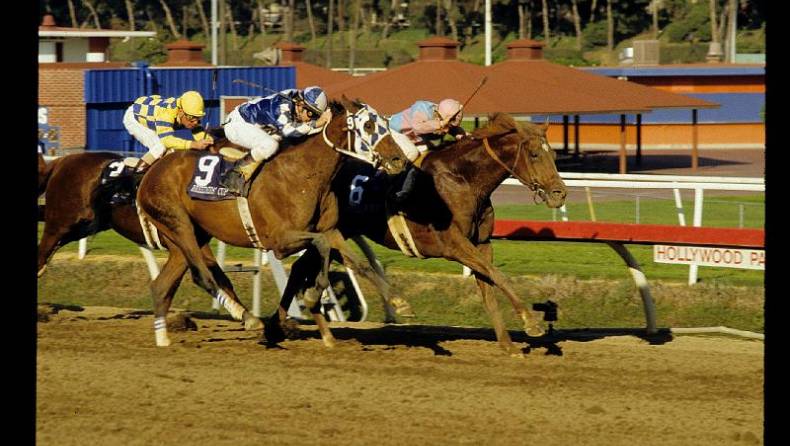
By Peter Lee
They were both champions as 3-year-olds; Ferdinand had surprised the horse racing world just a year earlier with an upset in the 1986 Kentucky Derby, ridden by then-54-year-old Bill Shoemaker. Alysheba, just a year younger, had overcome a stumble in the stretch at Churchill Downs to win the 1987 Derby under Chris McCarron and had won the Preakness Stakes as well.
The 1987 Breeders’ Cup Classic would be the first time two Derby champions had faced off against each other since Affirmed and Spectacular Bid met in the 1979 Jockey Club Gold Cup. Although he was a year older and more mature, Ferdinand had been inconsistent during his 4-year-old campaign, having lost his first five races on the West Coast (two on grass) and then pulling off a three-race winning streak to prepare for the Classic.
Alysheba had taken nearly two months off since winning the Super Derby on Sept. 27 and was ready for a fight. “He’s as good right now as he was at the beginning of the year,” trainer Jack Van Berg told the Associated Press. “He’s fit. He’s been training good. He’s ready.”
Although the two were favored to win the race—Ferdinand at 5-2 and Alysheba at 7-2—they faced stiff competition from 1986 Breeders’ Cup Classic champion Skywalker, who was coming back from a broken leg earlier in the year but had been training well; Afleet, a Canadian horse who had won the Jerome Handicap and Pennsylvania Derby; and Judge Angelucci, who was trained by 74-year-old Charlie Whittingham, the same person who trained Ferdinand.
On Nov. 21, Hollywood Park was crammed with 57,734 people eager to see only the fourth Classic in history. Both Ferdinand and Alysheba had drawn good post positions: Ferdinand had the No. 6 post, and Alysheba would start from the No. 9 position out of the 12-horse field.
As the gates opened, Ferdinand started well. He then settled back to let Judge Angelucci take over. who along with Candi’s Gold set moderate fractions for the first part of the mile-and-a-quarter race. Ferdinand had settled back into sixth place, running along the rail, while Alysheba was about nine lengths off the lead, trailing almost everyone back in ninth place.
Down the backstretch, the two leaders ran as one, with He’s a Saros and Good Command running also as a pair a length behind them. Ferdinand started to make his move on the four at the tail end of the backstretch, while Alysheba bided his time before making a run around the far turn.
Those six horses were so bunched up coming around the turn that the two favorites had nowhere to go. Shoemaker had positioned Ferdinand more to the outside and went four wide around the leaders. McCarron, who was getting toward the front late, had to settle for five wide around the turn and lost some ground.
The crowd roared as they saw the horses bunched together at the front, Candi’s Gold stubbornly holding on to a half-length lead over Judge Angelucci, who was poised to make his run. He overtook Candi’s Gold at the sixteenth pole, but Ferdinand quickly caught him. The two fought nose-to-nose down the stretch, and it looked like Ferdinand was trying to avoid a huge upset by his stablemate.
Here came Alysheba. As always, late to the show, he rocketed toward the front, overtaking Judge Angelucci in the final 50 yards and setting his sights on Ferdinand. He caught him at the wire easily, but it ended in a photo finish.
The wait was on. The crowd grew restless waiting for the result. Did Alysheba have enough track to overtake his rival? Or had Ferdinand hung on with his experience and tenacity?
Finally, the stewards posted the numbers. It was No. 6, Ferdinand, by the slimmest of margins. Alysheba was second, and Judge Angelucci had hung on for third.
For his victory, Ferdinand was named both Champion Older Male Horse and Horse of the Year in 1987. Alysheba was named Champion Three-Year-Old Colt.
Alysheba got his revenge the next year in the 1988 Santa Anita Handicap and San Bernardino Handicap, beating Ferdinand in both races. He got his victory in the Classic that same year to become the leading money winner in history at the time. Like Ferdinand, he was named Champion Older Male Horse and Horse of the Year for 1988.
As most know, sadly, Ferdinand was sold to a Japanese stud farm in 1994, and eight years later was callously sent to slaughter, prompting the creation of several nonprofit groups to keep old racehorses alive.
Courtesy of Breeders’ Cup



